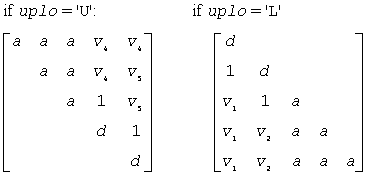Developer Reference for Intel® oneAPI Math Kernel Library for Fortran
A newer version of this document is available. Customers should click here to go to the newest version.
Visible to Intel only — GUID: GUID-2BD9E50B-725C-4239-B488-4DA15947AC79
Visible to Intel only — GUID: GUID-2BD9E50B-725C-4239-B488-4DA15947AC79
?latrd
Reduces the first nb rows and columns of a symmetric/Hermitian matrix A to real tridiagonal form by an orthogonal/unitary similarity transformation.
Syntax
call slatrd( uplo, n, nb, a, lda, e, tau, w, ldw )
call dlatrd( uplo, n, nb, a, lda, e, tau, w, ldw )
call clatrd( uplo, n, nb, a, lda, e, tau, w, ldw )
call zlatrd( uplo, n, nb, a, lda, e, tau, w, ldw )
Include Files
- mkl.fi
Description
The routine ?latrd reduces nb rows and columns of a real symmetric or complex Hermitian matrix A to symmetric/Hermitian tridiagonal form by an orthogonal/unitary similarity transformation QT*A*Q for real flavors, QH*A*Q for complex flavors, and returns the matrices V and W which are needed to apply the transformation to the unreduced part of A.
If uplo = 'U', ?latrd reduces the last nb rows and columns of a matrix, of which the upper triangle is supplied;
if uplo = 'L', ?latrd reduces the first nb rows and columns of a matrix, of which the lower triangle is supplied.
This is an auxiliary routine called by ?sytrd/?hetrd.
Input Parameters
- uplo
-
CHARACTER*1.
Specifies whether the upper or lower triangular part of the symmetric/Hermitian matrix A is stored:
= 'U': upper triangular
= 'L': lower triangular
- n
-
INTEGER. The order of the matrix A.
- nb
-
INTEGER. The number of rows and columns to be reduced.
- a
-
REAL for slatrd
DOUBLE PRECISION for dlatrd
COMPLEX for clatrd
DOUBLE COMPLEX for zlatrd.
Array, DIMENSION (lda, n).
On entry, the symmetric/Hermitian matrix A
If uplo = 'U', the leading n-by-n upper triangular part of a contains the upper triangular part of the matrix A, and the strictly lower triangular part of a is not referenced.
If uplo = 'L', the leading n-by-n lower triangular part of a contains the lower triangular part of the matrix A, and the strictly upper triangular part of a is not referenced.
- lda
-
INTEGER. The leading dimension of the array a. lda≥ (1,n).
- ldw
-
INTEGER.
The leading dimension of the output array w. ldw≥ max(1,n).
Output Parameters
- a
-
On exit, if uplo = 'U', the last nb columns have been reduced to tridiagonal form, with the diagonal elements overwriting the diagonal elements of a; the elements above the diagonal with the array tau, represent the orthogonal/unitary matrix Q as a product of elementary reflectors;
if uplo = 'L', the first nb columns have been reduced to tridiagonal form, with the diagonal elements overwriting the diagonal elements of a; the elements below the diagonal with the array tau, represent the orthogonal/unitary matrix Q as a product of elementary reflectors.
- e
-
REAL for slatrd/clatrd
DOUBLE PRECISION for dlatrd/zlatrd.
If uplo = 'U', e(n-nb:n-1) contains the superdiagonal elements of the last nb columns of the reduced matrix;
if uplo = 'L', e(1:nb) contains the subdiagonal elements of the first nb columns of the reduced matrix.
- tau
-
REAL for slatrd
DOUBLE PRECISION for dlatrd
COMPLEX for clatrd
DOUBLE COMPLEX for zlatrd.
Array, DIMENSION (lda, n).
The scalar factors of the elementary reflectors, stored in tau(n-nb:n-1) if uplo = 'U', and in tau(1:nb) if uplo = 'L'.
- w
-
REAL for slatrd
DOUBLE PRECISION for dlatrd
COMPLEX for clatrd
DOUBLE COMPLEX for zlatrd.
Array, DIMENSION (ldw, n).
The n-by-nb matrix W required to update the unreduced part of A.
Application Notes
If uplo = 'U', the matrix Q is represented as a product of elementary reflectors
Q = H(n)*H(n-1)*...*H(n-nb+1)
Each H(i) has the form
H(i) = I - tau*v*v'
where tau is a real/complex scalar, and v is a real/complex vector with v(i:n) = 0 and v(i-1) = 1; v(1: i-1) is stored on exit in a(1: i-1, i), and tau in tau(i-1).
If uplo = 'L', the matrix Q is represented as a product of elementary reflectors
Q = H(1)*H(2)*...*H(nb)
Each H(i) has the form H(i) = I - tau*v*v'
where tau is a real/complex scalar, and v is a real/complex vector with v(1: i) = 0 and v(i+1) = 1; v( i+1:n) is stored on exit in a(i+1:n, i), and tau in tau(i).
The elements of the vectors v together form the n-by-nb matrix V which is needed, with W, to apply the transformation to the unreduced part of the matrix, using a symmetric/Hermitian rank-2k update of the form:
A := A - VW' - WV'.
The contents of a on exit are illustrated by the following examples with n = 5 and nb = 2:

where d denotes a diagonal element of the reduced matrix, a denotes an element of the original matrix that is unchanged, and vi denotes an element of the vector defining H(i).